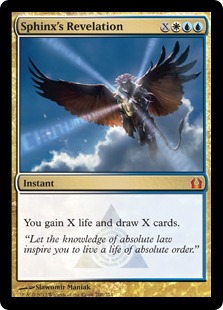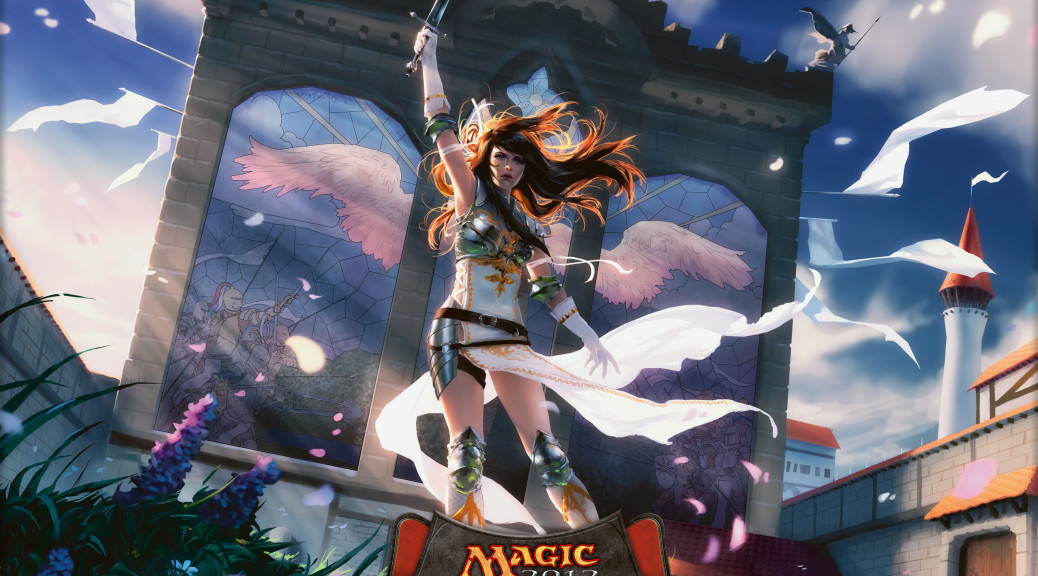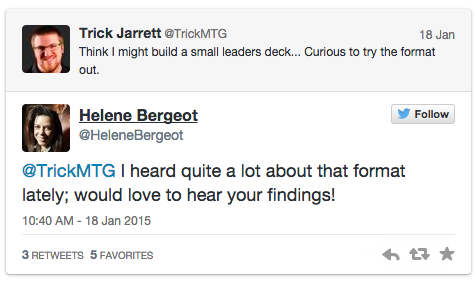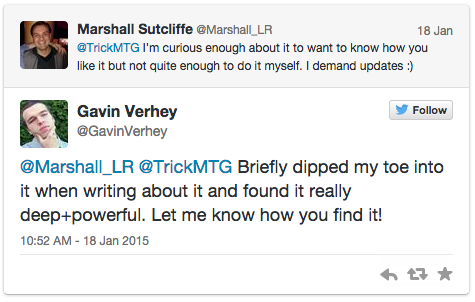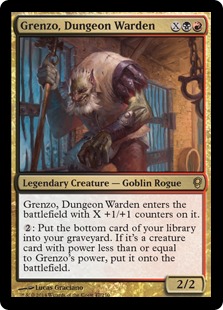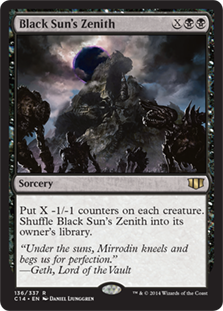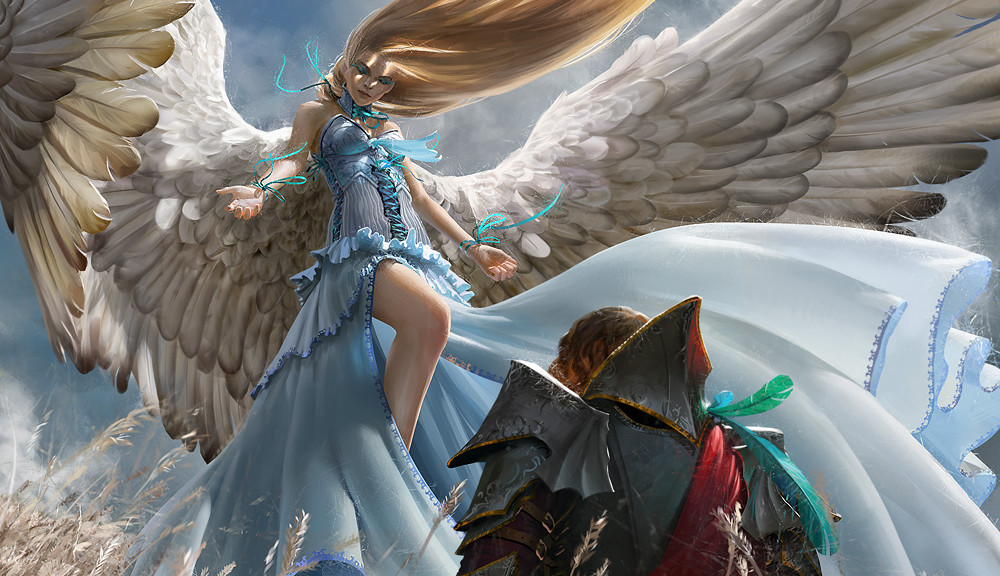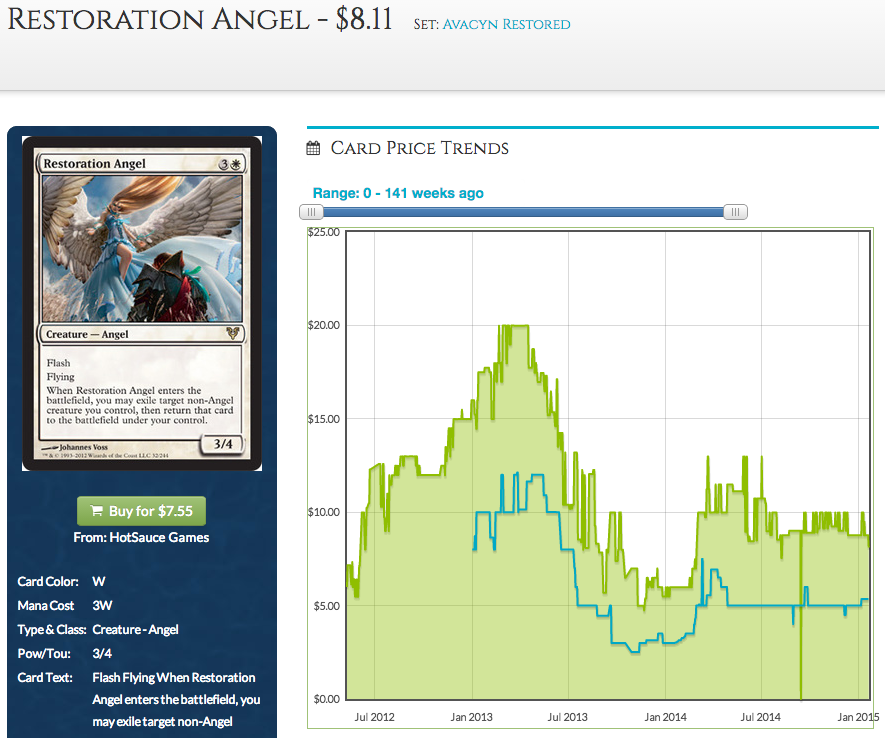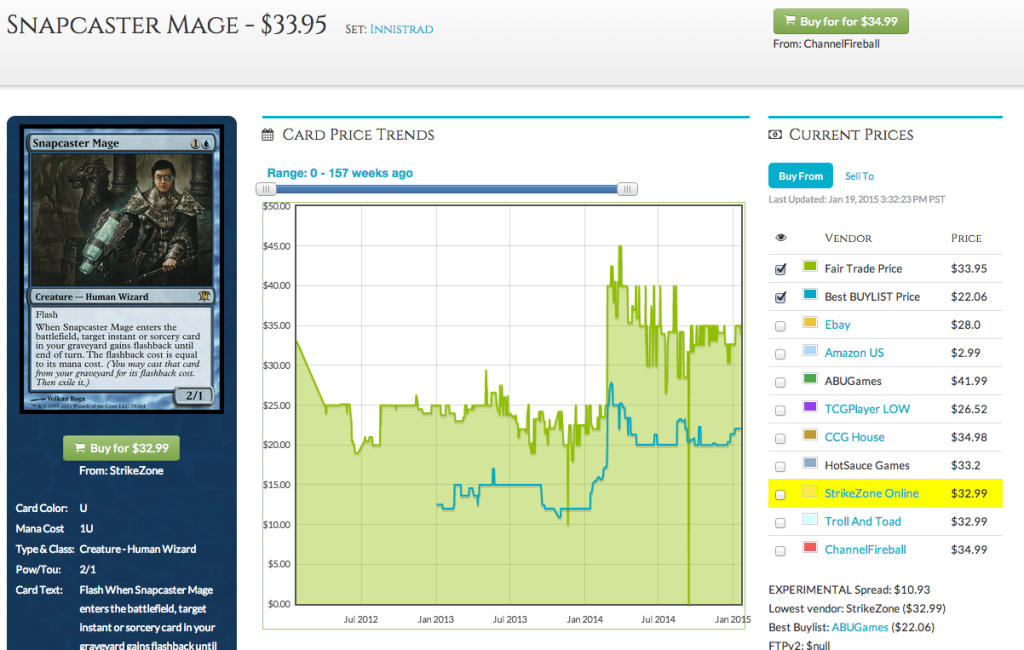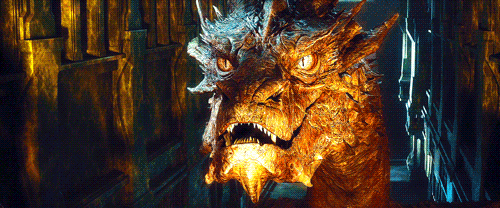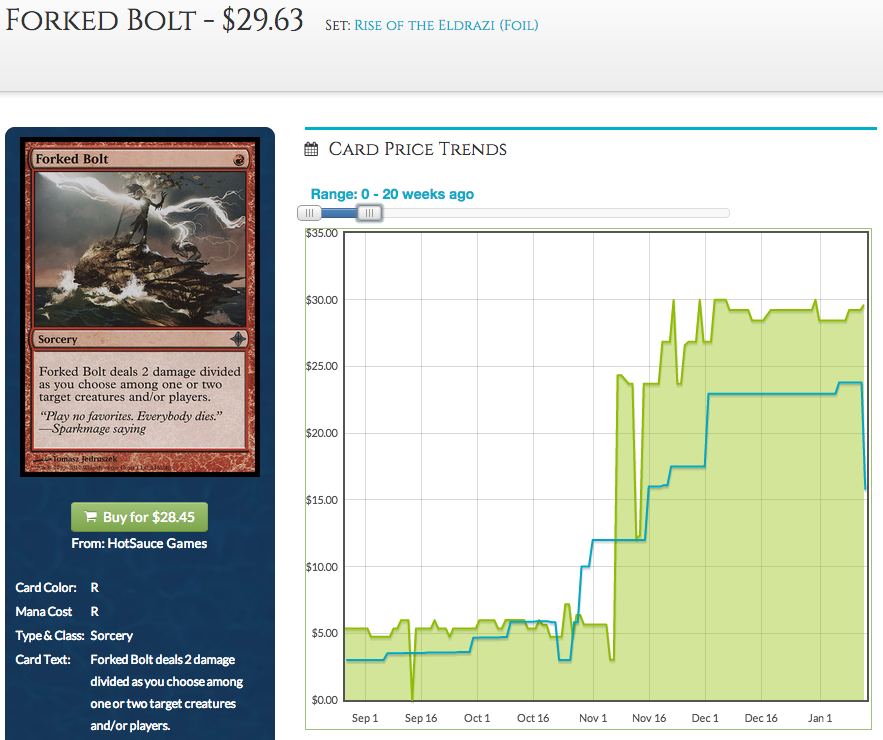By Guo Heng Chin
I initially planned to write solely about cards to watch during Pro Tour Fate Reforged. However, I’ve had the chance to participate in the first ever Tiny Leaders tournament in Malaysia over the weekend and friend and fellow Magic player @rezaaba convinced me that I should probably do a report on the event. So today’s article is going to be a two-in-one (talk about value for your time): the first portion discusses the cards which I am keeping an eye on as we count down towards the Pro Tour this weekend and throughout the Pro Tour. The second segment would be a round-by-round report of the Tiny Leaders tournament I attended.
Throwing My Hat into the Ring
The following are cards are possibly undervalued at the moment in terms of their price in relation to the amount of play they currently see and could potentially see. These are cards that could experience a spike if decks they running them performs at the Pro Tour.
Data on the post-ban metagame is sparse, with only five Modern Daily Events (the bans were enforced on Magic Online from 28 January onwards) and two StarCityGames Premier IQs. Going through the data, there is one deck that stood out, Amulet Bloom. It took down last weekend’s StarCityGames Premier IQ and is the most successful combo deck in the Modern Daily Events, comprising of 4.6% of the field. The deck is not exactly dominant, but it seems that reports of the death of Amulet Bloom have been greatly exaggerated. The deck is of interest financially because the namesake card of the deck could spike in price if Amulet Bloom spikes Pro Tour Fate Reforged.
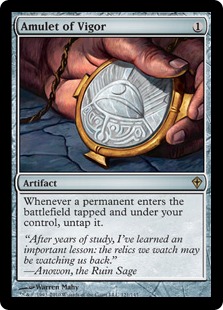
Amulet of Vigor is at $3.05 even though the strategy of the archetype hinges on Amulet. If you are looking to invest in Amulet of Vigor, do keep in mind that it would be a short-term investment as Amulet of Vigor is at risk of being reprinted in Modern Masters 2015, although it escapes my mind what sort of limited archetype in Modern Masters would Amulet fit in.
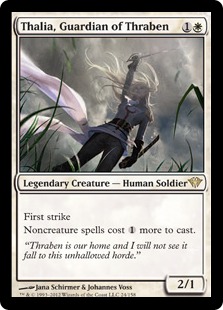
I often wonder why Thalia, Guardian of Thraben remains so cheap despite the amount of play she is currently seeing in Modern and Legacy. Thalia is present in Modern Hatebears, Modern Death and Taxes and the occasional Modern Zoo. You can also find her in Maverick and Death and Taxes in Legacy. And decks running Thalia want to run three to four copies of her. Most importantly, Thalia is not going to be reprinted in Modern Masters 2015, and by the virtue of being the Guardian of Thraben, we are unlikely to find her anywhere else but on the plane of Innistrad.
Seeing that I have been raving about Tiny Leaders lately, it is worth noting that Thalia is also solid leader in the format. Thalia is reputedly a favorite of Bramwell Tackaberry, the progenitor of the Tiny Leaders, and has been topping of the Winnipeg Tiny Leaders scene.
Thalia is a card that would eventually bump up in price as her current price of $4.38 is out of sync with the amount of eternal play she has been seeing. Unfortunately the chance that her price would be bumped by Pro Tour Fate Reforged looks to be slim, for the fact that the Pro Tour metagame is historically skewed towards midrange or blue-based decks. Thalia is a card I consider a good great long-term investment, at least until the following Modern Masters is announced, which we probably would not see until 2017.
I wrote about the next two cards in my article a short while ago. I am revisiting them today as there were new developments during the two weeks that have passed.
Since the announcement of the bans on 19 January, Sphinx’s Revelation spiked on Magic Online from the 9.8 tickets it was hovering at before settling at 16.8 tickets, but remained at $6.18 on paper, which was pretty much the same price it was at when I wrote my previous article. Modern staples are generally cheaper online due to the larger quantity of boosters being drafted online; when a key component of one of the potential new overlords of Modern is nearly three times more expensive online than its paper counterpart, a price correction is inbound. I think it is paper Sphinx’s Revelation that is due for correction, rather than the digital one.
I mentioned in my previous article – before we got any data on the post-ban metagame – that Thundermaw Hellkite would soar once more if Lingering Souls becomes prevalent again. Lingering Souls was ran in 19.8% of all the decks that moneyed the five Modern Daily Events since the bans were implemented on Magic Online and 18.6% of the top 16 decks (3 out of 16) in the StarCityGames IQ in Washington two weeks back (but none in last week’s IQ in Indianapolis as no Abzan Midrange decks made top 16). Lingering Souls has got its staple status reinstated in Abzan Midrange, one of the most popular decks in the post-ban Modern landscape.
Thundermaw Hellkite could very well be a level one tech at the Pro Tour designed to trump Abzan Midrange, which is predicted to be one of the most played tier one decks at the Pro Tour. Thundermaw Hellkite plays the role as a curve-topper in Jeskai Geist and Big Zoo. If Thundermaw sees a decent amount of play at the Pro Tour, I doubt Thundermaw’s price would remain under $10 as it is now ($9.25 as of writing). If you are looking to invest in Thundermaw Hellkite, it might be best to consider it a short-term investment due to the possibility of reprint in Magic 2016, as I have explained in my previous article.
Chord in a Post-Pod World
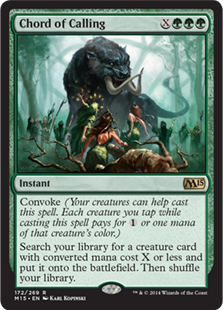
As someone who has lived through the era of $40 Chords, I’ve mentioned on multiple occasions that Chord of Calling is unbelievably cheap at the $3.40 it is at right now. While Chord of Calling was discarded by Birthing Pod decks in the final chapter of the archetype’s evolution in favor of a less combo-reliant build, Chord is now a potential saviour of the archetype.
Jay Lansdaal wrote about a few different Pod shells that could be given a breath of new life with Chord of Calling. The lists harked back to the days of yore when Pod decks were combo decks with a beatdown backup plan. Chord of Calling replaced Birthing Pod in helping you assemble the combo pieces, whose tutoring capabilities also imbued the deck with toolbox capabilities.
Chord of Calling was also seen as a playset in Elves, which finished 9th at the recent StarCityGames IQ in Indianapolis. It could be a fluke performance of that archetype, but we are traversing uncharted territory in Modern, a landscape free from the subtly oppressive dominion of Pod decks, and for all we know Elves might actually be viable now.

Speaking of Birthing Pod replacements, Domri Rade is another value engine option as featured in Jay Lansdaal’s Kiki Pod Chord shell and Redditor /u/OctilleryLOL‘s iteration of Kiki Chord. Together with Courser of Kruphix, Domri Rade is a beast of an advantage engine. At $6.86, Domri has a lot of room to grow if decks running Domri performs, especially if Kibleresque Zoo decks becomes viable.
Moonshot Card
This new tech has been floating around for a while, but I’ve only stumbled upon it courtesy of Travis Allen‘s tweet.
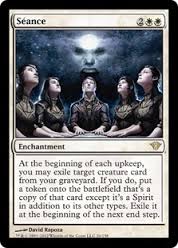
Redditor /u/hp94 did pretty well with the list which possessed favorable matchups against BGx decks and Affinity. Magic Online user RaptureReady went 3 – 1 in a Modern Daily with a slightly modified list after reading the Reddit post. Like Pod, the deck is chock-full of value creatures, and to put it in Travis’ word, it is pretty much a Pod deck that runs Séance instead of Birthing Pod. And from what I’ve read, Séancing a Siege Rhino or Mulldrifter is quite a lot of value.
There has yet to be more results since then, though it has only been a little more than a week ago. Séance looks like a legitimate successor to Birthing Pod and at the bulk price of $0.29, it is a card worth keeping an eye on for the Pro Tour. It does not take much for a relatively old card like Séance to jump.
Tiny Leaders Tournament Report
The first ever Tiny Leaders tournament in Malaysia was held last week. Shout-out to the tournament organiser Kelvin Seow at HQ Sri Petaling for the initiative and the wonderful players who gave their support to the event. The turnout for the event surpassed our expectations: 15 players for a new format in the local Magic scene.
I ran the Anafenza, the Foremost list which I posted at the end of my article last week. The deck drew its inspiration from Modern Pod decks: it attacks from two angles with a beatdown plan A and Melira combo plan B.
Round 1 – Athreos, God of Passage
A few of the players participating in the tournament built their Tiny Leaders the night before just to play in the tournament. Unfortunately, my first round opponent was one of them and I felt bad jamming a refined Abzan list against him. Kudos to him though, for building the deck the night before (if I recall correctly, he heard of the tournament the night before) and coming to support the LGS in their first ever Tiny Leaders tournament.
1-0
Notes from the round: Tiny Leaders is as competitive as non-rotating formats like Modern and Legacy and tuned decks would walk over untuned lists. This should not be viewed as a downside as it applies to Modern and Legacy, and to some extend, Standard as well. Budget options are available for Tiny Leaders, and a good tier one is Anex and Cymede, which I would be writing about in my next article.
Round 2 – Geist of Saint Traft
My second round opponent, Kean ran a well-tuned Geist of Saint Traft list and the power level and fun of Tiny Leaders manifested itself in this match. Game one was a close grind as we exchanged removals for each other’s haymakers. It felt a bit like Legacy: Kean resolved a Stoneforge Mystic searching for his Sword of Feast and Famine, I ripped a Thoughtseize the next turn and got rid of it.
After bashing at me with Geist of Saint Traft and other pesky evasive creatures and building a board position for the kill the next turn, he tapped out and I managed to resolve a Chord of Calling to assemble the Melira combo.
Sideboard: + Wrench Mind, +Council’s Judgement, +Sin Collector, +Cruel Edict, –Scavenging Ooze, –Dismember -Llanowar Elves, -Sword of Feast and Famine
In game two Kean fell on the wrong side of variance as he mulliganed to five and I proceeded to draw Wrench Mind (my Hymn to Tourach) and Thoughtseize.
2-0
Notes from the round: Kean pointed out a poignant observation about how Tiny Leaders differ from Legacy and Modern. Certain color combinations have access to less removals than they usually do due to the singleton nature of Tiny Leaders. My Dark Confidant survived longer than he should have in game one as Kean did not draw into one of his two answers: Swords to Plowshares or Path to Exile. The amount of card I drew off Dark Confidant allowed me to assemble the Melira combo pieces in the nick of time before he could swing for lethal.
Round 3 – Ezuri, Renegade Leader
Ah, the dreaded Elfball deck. Besides Geist of Saint Traft, Ezuri Elfball was the other deck I dedicated the most sideboard slots to. In game one, I was overruned by elves as I attempted to develop my board position from a slow opening hand.
Sideboard: +Zealous Persecution, +Drown in Sorrow, +Golgari Charm, -Sword of Fire and Ice, -Thoughtseize, -Lingering Souls
In game two I assumed the control role and sandbagged my removals for key creatures like his Elvish lords, Ezuri and any elf that could generate more than one mana. It is difficult to outsize his board position as he is a swarm deck after all. It was a close back-and-forth battle: I thought my chances were good when I managed to connect with a Sword of Feast and Famine-wielding Anafenza, but he has a Reclamation Sage to remove it before shoring up his board position with elves that grew in to outsize my creatures in power and toughness. I took game two one turn away from a whooping 30 damage Elvish alpha strike on the back of the Melira combo.
I got greedy in game three, keeping a hand with Zealous Persecution and Golgari Charm but only one land which was a Wooded Foothills. Most of my opponent’s elves were 1/1 prior to any lords and I reasoned that if I drew one more of my 18 remaining lands, or one of my four mana dorks, I would be able to reset his board twice. Alas, I saw no lands nor mana dorks until he has an Elvish Champion in play and I was quickly dispatched. Thankfully my opponent, Keith ended up taking down the whole tournament and propping up my tiebreakers.
2-1
Notes from the round: Elfball was slower I imagined it to be. The deck still has one of the fastest board-building speed in the format, but it does not go critical until it could untap with either Priest of Titania or Elvish Archdruid. It is imperative to keep those two off the board or answer them as soon as possible. Allowing your Elfball opponent to untap with either of those in play means facing an exponential growth in the number of elves and a quick trip to the next game.
It is also important to keep Ezuri off the board due to his ability to regenerate other elves. Dismember was MVP here as it gets around Ezuri’s regeneration shield (for other elves, if you could not afford to remove Ezuri first). I would prioritise removing Elfball’s Priest and Archdruid, followed by the lords and Ezuri.
Round 4: Vendilion Clique
Vendilion Clique turned out to be one of the most popular leaders in the tournament as a lot of the participants were Duel Commander players and they ported over their Duel Commander decks. My final round opponent was local alterist extraordinaire, Patterson and he sported some of the most gorgeous-looking basic islands I have seen.
Game one was a drawn-out grind for me to amass a board position amid his flurry of counterspells and bounces. He flooded out in the mid-game as he ripped one too many islands in succession (perils of having beautiful islands), which allowed me to sneak in a Midnight Haunting and bolster my tokens with Gavony Township. An Ancestral Visions did not draw him into the Cyclonic Rift he was looking for and it was game two.
Sideboard: +Reclamation Sage, +Phyrexian Arena, +Wrench Mind, + Sin Collector, +Golgari Charm, -Dismember, -Smother, -Scavenging Ooze, -Swords to Plowshare, -Llanowar Elves.
I took out all my creature removals as there were no targets beyond Vendilion Clique and I have flying spirit tokens to handle that. The excessive number of artifact and enchantment removal stemmed from my fear of Back to Basics and getting Vedalken Shackled out of the game. Rightfully so, game two would have been lost had I not have a Reclamation Sage in hand when he resolved his Vedalken Shackles.
Notes from the round: Playing against blue was not as dreadful as I initially thought. The lack of board wipes meant that the fight was to resolve a few threats through his counterspells and bounces, and bounces were net negative in terms of card advantage. However, blue does have a lot of deadly enchantments and artifacts post-board that could wreck a tricolor creature-based deck if left unanswered.
3-1 (finished second)
Overall, the tournament was a hell of an experience. The complexity of Tiny Leaders and the decision trees available definitely felt like playing Legacy, or at the very least competitive Duel Commander. The singleton restriction was one of the factor as it promoted diversity in answers and threats. I have yet to amass enough Tiny Leaders experience to point out its flaws (and I am certain there are some), and from what little experience I’ve had, Tiny Leaders filled a gap for me by providing a format where I can experience the thrills of Legacy at a fraction of its cost and the fun of Commander without the long-drawn out games.
Track your collection's value over time, see which cards moved the most, track wishlists, tradelists and more. Sign up at MTGPrice.com - it's free!

